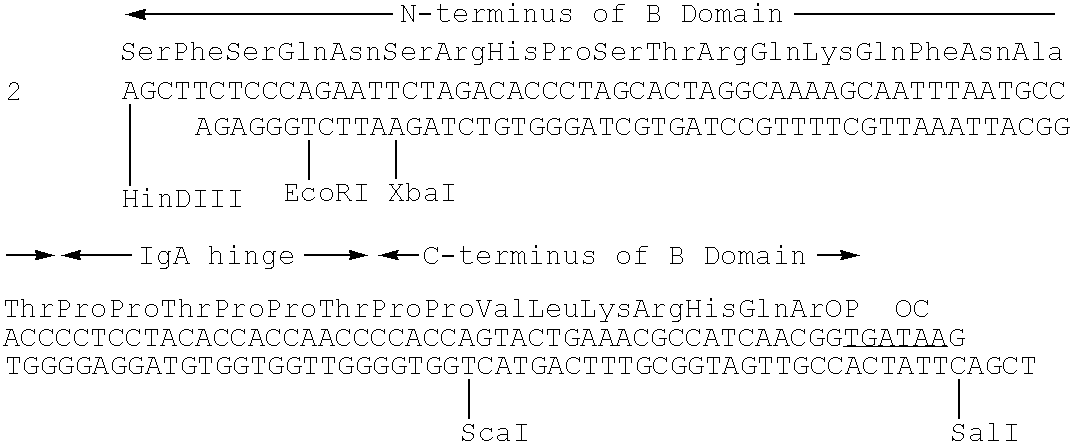Protein complexes having factor VIII:C activity and production thereof
a technology of protein complexes and c activity, applied in the field of protein complexes having factor viii c activity, can solve the problems of difficult purification and characterization, and achieve the effects of high stability, high yield and high yield
- Summary
- Abstract
- Description
- Claims
- Application Information
AI Technical Summary
Benefits of technology
Problems solved by technology
Method used
Image
Examples
example 1
Preparation of Expression Plasmids
[0045] (A) pSV7d:
[0046] The expression cassettes were prepared using the mammalian cell expression vector pSV7d (2423 bp).
[0047] The plasmid pSV7d (see Truett et al, supra) was constructed as follows: The 400 bp BamHI / HindIII fragment containing the SV40 origin of replication and early promoter was excised from pSVgtI (obtained from Paul Berg, Stanford University, California) and purified. The 240 bp SV40 BclI / BamHI fragment containing the SV40 polyA addition site was excised from pSV2 / DHFR (Subramani et al, Mol Cell Biol (1981) 1:854-864) and purified. The fragments were fused through the following linker:
This linker contains five restriction sites, as well as stop codons in all three reading frames. The resulting 670 bp fragment containing the SV40 origin of replication, the SV40 early promoter, the polylinker with stop codons and the SV40 polyadenylation site was cloned into the BamHI site of pML, a pBR322 derivative having about 1.5 Kb del...
example 2
[0076] Expression of the Mr 92 K protein in COS7 cells using the pSVF8-92 construction was low compared to the amount of Mr 80 K protein produced. The Mr 92 K protein is apparently retained and / or degraded in the Golgi pathway, and is not efficiently processed or exported. Accordingly, the construction was modified in an attempt to increase the level of Mr 92 K protein. Modifications of the following types were made: Changes in the 5′ untranslated sequence of the Factor VIII:C gene; inclusion of heterologous 5′ untranslated and leader sequences; and changes in the 3′ untranslated sequences. These constructs are summarized below.
[0077] (A) 5′ Untranslated Region Modifications Plasmid pSVF8-92B. This plasmid is a derivative of pSVF8-92 in which the 30 bp of 5′ untranslated sequence of pSVF8-92 is replaced with the entire 5′ untranslated region of human Factor VIII:C cDNA (nucleotides 1 to 171; see FIG. 8 of Truett et al, supra), with a deletion of the G-C tails (by in vitro site-spec...
example 3
[0087] This example describes the preparation of constructs for producing polypeptides that consist of the Mr 92 K chain and a portion of the B domain. These derivatives were made in an attempt to develop a heavy chain that is more stable and / or assembles more efficiently into an active complex with the light chain. The derivatives were chosen to mimic molecular species that have been observed in plasma-derived preparations of Factor VIII:C and in cell lysates and conditioned media from cells expressing recombinant full-length Factor VIII:C. Polypeptides of approximately the same size could possibly arise by thrombin cleavages of full-length Factor VIII:C.
[0088] (A) pSVF8-92S: This plasmid encodes a 982 amino acid heavy chain and was prepared from a full-length cDNA plasmid pSVF8-302 by cleavage at the first SacI site of the B-domain coding region. An oligonucleotide adaptor was used to install a translational stop codon and fuse the coding sequence to the natural human Factor VIII...
PUM
| Property | Measurement | Unit |
|---|---|---|
| Volume | aaaaa | aaaaa |
| Volume | aaaaa | aaaaa |
| Volume | aaaaa | aaaaa |
Abstract
Description
Claims
Application Information
 Login to View More
Login to View More - R&D
- Intellectual Property
- Life Sciences
- Materials
- Tech Scout
- Unparalleled Data Quality
- Higher Quality Content
- 60% Fewer Hallucinations
Browse by: Latest US Patents, China's latest patents, Technical Efficacy Thesaurus, Application Domain, Technology Topic, Popular Technical Reports.
© 2025 PatSnap. All rights reserved.Legal|Privacy policy|Modern Slavery Act Transparency Statement|Sitemap|About US| Contact US: help@patsnap.com



